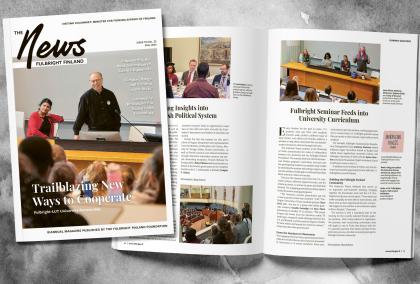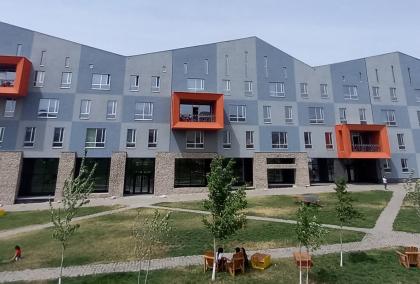Study programs are organized according to a module plan and course assessments provided in the ECTS system. Many masters level programs are available in English. Instruction at institutions of higher education is free of charge for degree students for students from the EU/EEA countries (with some exceptions). Master’s degree programs for non-EU/EEA nationals have tuition fees.
Bachelor’s and Master’s students pay a small membership fee to their institution’s student union every year (this fee is not mandatory for universities of applied sciences). In return, they get reduced-price meals, health care services and other social benefits.
Get a student card if at all possible. It makes travel significantly cheaper and gives access to cheap lunches at the university. -U.S. Student Grantee 2013-2014
Students are eligible for higher education when they have passed the matriculation examination or received a vocational qualification.
Students nationwide apply to higher education institutions by using the electronic system, StudyInfo, maintained by the National Board of Education.
Universities
The basic task of the universities is to engage in scientific research and provide the highest level of education based on it. Universities promote lifelong learning, interact with society and promote the societal impact of research results and artistic activities.
To guarantee the freedom of science, the arts and higher education, universities are autonomous actors. Universities are independent legal entities that have the right to make independent decisions on matters related to their internal administration.
Studies at Finnish universities are very independent. Even at the Bachelor’s level, students are responsible for their own study plans, and have a high degree of flexibility when it comes to planning when they will take the various courses and exams that make up their degree.
The courses of study are rigorous and admission is difficult. On the other hand, there are no tuition fees except in some International programs (usually taught in English), MBA and LLM courses, etc., and students are eligible for government financial aid and some grants.
Due to the structure of the Finnish university system, students are relatively free to determine the rate and direction of their courses of study. Many courses may be passed by readings and examinations on prescribed books in lieu of lecture attendance. Moreover, both course and departmental examinations may be retaken several times.
Unlike in the case of many U.S. universities, courses and course times are not assigned to students in Finland by a central computer, and many Finnish students may unfortunately have courses whose schedules inevitably overlap, especially since students often need to take courses for their minor subjects in faculties outside that of their major subject. -U.S. Fulbright Alumna currently working as a professor in a Finnish university
Finnish university society is centered around the many social organizations. Join as many as you can! -U.S. Student Grantee 2013-2014
University Degree Requirements
Finland is part of the European-wide so-called “Bologna-process.” The degree structure is mainly based on a two-cycle model. The first cycle, lasting a minimum of three years, ends in a Bachelor-level degree. The second cycle consists of Master's and Doctoral degrees. Finnish university degrees are equivalent to the Bachelor’s (kandidaatti) and Master’s (maisteri) degrees in American higher education.
Each higher education institution decides on which students it admits as well as on the criteria on the basis of which students are selected for admission.
In the Finnish system of higher education, the concept of faculty refers to a comprehensive unit of several departments (school), not individual academic staff or teachers. A faculty is an administrative unit.
University Degrees
Unlike in many other countries, the student is admitted to a university with a right to complete both a bachelor’s (minimum of 3 years, 180 Finnish credits) and a master’s degree (minimum of 2 years, 120 Finnish credits). The vast majority of students also have a master’s degree as their first goal and at present very few students leave university after the bachelor’s level. Finnish students often study more than six years to get their master’s degree.
After graduating from the Master’s level (which includes a Master’s thesis), students can apply for post-graduate studies. The two levels of postgraduate studies are Licentiate and Doctorate.
It sometimes comes as a surprise to American students holding a bachelor’s degree that in Finland they are usually considered as undergraduates. The term “graduate (or postgraduate) student” refers to students beyond the master’s level (jatko-opiskelija).
A bachelor’s degree usually consists of basic and intermediate studies in the major subject, including a bachelor’s thesis, studies in one or more subsidiary, or minor subjects, and language and communication studies. In addition to these, a master’s degree includes advanced studies and a master’s thesis, called the pro gradu.
There are a number of master’s degree equivalents in different disciplines. These are usually abbreviated to two or three letters. FM, for example, is short for filosofian maisteri (Master of Arts).
Beyond the master’s degree, one can study for the licentiate degree (lisensiaatin tutkinto), a sort of junior doctorate, and upon defense of a dissertation the licentiate holder may be awarded a doctorate (tohtorintutkinto). The licentiate, however, is quite rare. In most fields of study, it is also possible to start working for a doctorate directly after completing a master’s degree.
Lectures
Students have the choice of attending lectures and passing an exam based on these lectures, or taking an exam on required reading materials, which are considered equivalent to the lectures. There are also seminar type courses where discussion, extra reading and a paper or lecture diary is required. Student questioning of teachers, and vice versa, is not as common as in the United States. Degrees in the sciences will also include laboratory and practical work components, which cannot be compensated for by books or lectures alone.
Contact between students and teachers outside of the classroom is not customary, although teaching staff have mandatory weekly office hours. In some departments, the situation may be quite different, with close personal contact among teachers and students. Still, this is more often the exception than the rule.
Communication styles and cultural habits in Finland may not always be what you have been accustomed to. This is good to keep in mind when you prepare for your teaching at a Finnish institution. You may find that you need to give your students more time to respond to your question than you would at home. Allowing time for this process is important, for the dialogue that ensues is deeper and more vigorous. Be patient with what might seem like long moments of silence.
Examinations and Grading Scale
Usually departments have set exam dates, listed in university catalogs. In order to take a written examination (known as a faculty examination, referring to the administrative unit arranging the examination), the students enroll using the online exam registration system. The student must prove their identity upon leaving the exam. This procedure may vary slightly depending on the university.
Written examinations are also held at the end of lecture series for students who have opted for the lectures. These might not require advance registration, but it is advisable to check with the examiner at the beginning of the course.
Some lecture courses do not have final examinations at all, but require the completion of exercises and often regular or compulsory attendance. The procedure may vary locally. Some lecturers may offer take-home examinations, brief research papers, lecture diaries or summary reviews instead of formal examinations. Oral examinations are rare in the Finnish system.
One method of examination that I have used is to give a relatively large number of exam questions in advance to the students roughly two weeks before the exam. Students study all of these questions, but will only be asked half of the questions on the actual examination. The advantage of this method has been that for the students, there are no surprises - if they do not understand one of the questions, they have plenty of time to ask the teacher in advance about it. For the teacher, the advantage is that the students are studying a wide range of issues regarding the topic under study and will probably be better prepared with answers than in the case of an exam with surprise questions. -U.S. Fulbright Alumna currently working as a professor in a Finnish university
Student performance is documented by the university grading scale. According to the university degree system the courses are graded from 1 to 5 ( 5 being the highest). If you are familiar with the ECTS (European Credit Transfer System), the Finnish grading scale 1-5 is very similar (5=A, 4=B, C=3 etc.). Please consult your host department for details on the grading scale in use.
Some courses are graded simply on a pass/fail basis. Other number grades may also exist. If a student fails an examination or is otherwise not satisfied with the grade, the examination can usually be retaken on dates set by the examiner.
Credit System
The Finnish credit is based on the principle that 60 credits measure the workload of a full-time student during one academic year. This means roughly 30 credits per semester, or 15 credits in one 7-week span.
In most cases one credit / study point stands for around 25 to 30 working hours. The courses offered by the different departments vary greatly in the amount of credit offered.
Differences in Academic Structure
The Finnish academic structure differs markedly from that in the United States. Nowhere is this more apparent than in the format of course offerings and in the expectation that students and teachers have of each other.
Most Fulbright lecturers will be expected to offer two lecture series per term, with a teaching load of 4-6 hours per week, and perhaps also be involved in seminar leadership. This may not be unlike an American teaching load, but this is where the similarities end.
University Calendar - Semester and Class Schedules
There are 4 terms during the September - May academic year. There is a one week grading break between the terms and a one-month vacation at Christmas.
There are no regular summer sessions, although instruction is offered during the summer months within the open university system. Instruction is also offered by summer universities, which are administered separately from regular universities.
Akateeminen vartti - Academic Quarter
The Finnish academic hour, unless otherwise stated, runs from a quarter past the hour for 45 minutes. Thus, if you appear on the hour to present a lecture, you may find an empty room!
A two-hour lecture is two times 45 minutes. For example, a two-hour lecture scheduled to start at 10 will actually run from 10:15 to 11:45, unless you take a 15-minute break midway and end at noon sharp.
Naturally, there are differences between universities, so it is a good idea to check the scheduling system once you have arrived.
Lectures and Books
Courses are often built around lectures and assigned readings, and exams can be based on either or both. If you are teaching a class at a university, ask someone at your department about the appropriate amount of course literature for that class, as this may be different from what you are used to. Many courses are also available as “book exams” (lecture attendance is not required and the examiner provides a list of books and/or articles on which the exam is based).
Book purchase is seldom a feature of Finnish courses, at least on the scale that dominates at American universities. Student bookstores do not recycle books and buy back old books. Students are accustomed to borrowing the course reading materials from the university library instead of buying them.
In terms of course literature, I recommend that teachers use digital materials that are already on the internet. According to Finnish law, one may use pictures and information from the Internet freely for teaching purposes, but the photocopying of books and articles for teaching purposes usually requires a permit. The permit can often be arranged through one's university, but it requires extra effort. -Fulbright U.S. Alumna currently working as a professor in a Finnish university
Universities of Applied Sciences
The universities of applied sciences emphasize close contacts with business, industry and services, especially at the regional level, and the education has a pronounced occupational emphasis. They train professionals in response to labor market needs.
The universities of applied sciences carry out some R&D with a distinctly applied and practical emphasis, whereas scientific research is the mandate of the universities. They also conduct research and development, which supports instruction and promotes regional development in particular. Universities of applied sciences have extensive autonomy and freedom in education and research. They are independent legal entities and make independent decisions on matters related to their internal administration. An operating licence granted by the Government is required before any party can establish and manage a university of applied sciences.
University of Applied Sciences Degrees
Like university education, UAS education is also divided into the Bachelor’s and Master’s levels. UAS students often have to complete a three-year work experience requirement before they can apply to a UAS Master’s degree program.
Students with a Bachelor’s degree from a UAS may also apply to a Master’s program at a university, although they are often required to take additional courses.
Universities of applied sciences also arrange adult education and open education geared to maintain and upgrade professional competencies.
List of Universities of Applied Sciences in Finland


